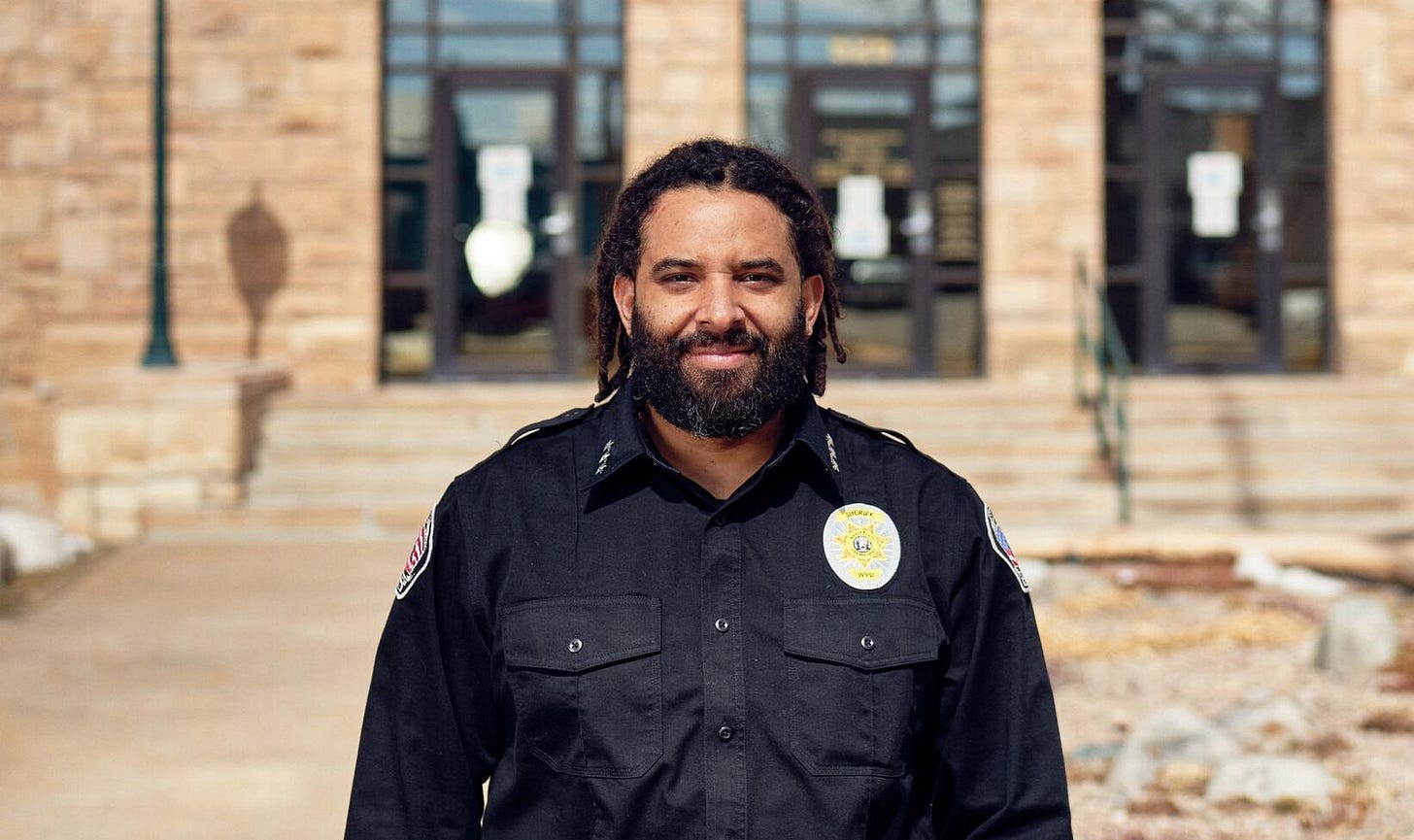Albany County Sheriff’s Office not partnering with ICE
Albany County’s sheriff, like the majority of Wyoming sheriffs, is not pursuing a 287(g) agreement with ICE. The program would come with expectations but not funding.
As other Wyoming sheriffs ink official agreements with U.S. Immigration and Customs Enforcement (ICE), Albany County Sheriff Aaron Appelhans said his agency will seek no such agreement.
Appelhans cited logistical and budgetary concerns, not ideological opposition, when he explained this decision to the Albany County Commissioners Tuesday.
“That is something I’m not considering here,” the sheriff said in response to a question posed by Commission Chair Terri Jones. “Albany County in no way, shape or form is going to be in a position to go through that 287(g) program anytime soon.”
The 287(g) program — named for the section of the federal Immigration and Nationality Act that authorizes it — allows state or local police agencies to carry out immigration enforcement on behalf of ICE. That’s a law enforcement responsibility usually reserved for the feds.
In Wyoming, four sheriff’s offices have signed at least one such agreement. Another, the Carbon County Sheriff’s Office, is listed as a “pending agency.”
Appelhans’ presentation this week came at the chair’s behest.
“[Jones] asked for a review of crime statistics,” the sheriff said, introducing that review during the commissioners’ regular bimonthly meeting. “She had been seeing some information on some local and national newscasts about a month ago, and just wanted to kind of see where we were in terms of Albany County.”
In addition to outlining his office’s relationship with ICE, Appelhans ran down general crime statistics for 2024 and 2025. He also fielded questions from the commission’s lone Democrat about the imminent repeal of gun-free zones.
Albany County and immigration law
Jones passed along several questions from constituents and asked her own. Prominent among them was a question about the sheriff’s office’s immigration dealings.
“Could you talk a little bit about how you handle cases that involve ICE and illegal aliens?” she said.

Appelhans explained that his agency is not in the business of enforcing federal immigration law.
“Our charges are local charges,” he said. “ICE — Department of Homeland Security — are federal charges. And so what we do in our jail is, if we get them in, they go through their due process on that local side.”
Being undocumented is a civil offense, not a criminal offense, so ICE’s proceedings “are civil in nature at that federal level, not criminal,” Appelhans said.
“So essentially, ICE has that decision on whether they want to go ahead and take that inmate and charge them federally, which would effect a transfer, or if they want to wait for the local process to go through first … If we have an inmate that’s awaiting court, they go through the court process and then they get released. We release them when the judge tells us to release them.”
That puts the ball in ICE’s court.
“So it’s up to the federal agency to come in and go through their federal process,” Appelhans said. “A local charge isn’t needed for the feds to go through their process. So a local charge doesn’t effectuate any of their civil warrants or their administrative warrants.”
This is where the optional 287(g) program comes in. Law enforcement agencies can sign an agreement with ICE that effectively deputizes local agents to enforce federal immigration law.
The practice has had its ups and down since it was first made possible in 1996. Only a small minority of police agencies have agreed to the program throughout its history, but there has been a surge of interest since President Trump took office in January.
Participating agencies are usually sheriff’s offices because those are the agencies that typically administer jails. Additionally, sheriffs, as elected officials, might have political incentives for being tough on immigration.
Appelhans, a Democrat, has campaigned as a progressive reformer, despite the office he helms catching criticism for an alleged lack of transparency and a spate of jail deaths from 2021-2022.
The sheriff did not voice opposition to ICE activities during his presentation to the commissioners, but did note there were ongoing concerns about the legality of the 287(g) program as it’s currently administered.
Working with ICE
The 287(g) program allows for three distinct types of agreements, Appelhans told the commissioners.
“There’s one where you can deputize your deputies to go out into the community and enforce immigration and customs law,” he said. “There’s one where you can deputize your detention deputies to investigate immigration and customs law. And then there’s one where you can deputize your detention deputies to essentially enforce ICE federal law.”
Respectively, those are known as the warrant service officer model (WSO), the task force model (TFM), and the jail enforcement model (JEM).
In Wyoming, as of this story’s publication:
The Carbon County Sheriff’s Office is pursuing a WSO agreement;
The Campbell County Sheriff’s Office has signed a WSO agreement;
The Laramie County Sheriff’s Office has signed a JEM agreement, and is pursuing both WSO and TFM agreements;
The Natrona County Sheriff’s Office has signed a WSO agreement;
The Sweetwater County Sheriff’s Office has signed all three possible agreements.
Albany County won’t pursue any of the agreements, Appelhans said.
“I was approached in December, and the main reason why I denied it is, on a 287(g) program, you have to meet basically every federal detention standard that they have on the books,” the sheriff said. “You have to meet all the training standards that they have to enforce all of the federal laws as well.”
There’s not much incentive to go through that extra work, Appelhans said.
“Unfortunately, the federal government only provides oversight and consequences for that program,” he said. “They do not provide any funding or anything to help effectuate that program. Here at Albany County, we do not have the staff, the facility, or the infrastructure to be able to go through that 287(g) program.”
Despite not pursuing an official agreement, the sheriff’s office is in contact with ICE, Appelhans said. Like other police leaders, the sheriff is hoping for a heads-up before any federal enforcement action takes place in his jurisdiction.
“I’ve requested that they talk to the sheriff’s office and let us know, and go through a process that we call ‘deconflict’ to make sure that we know where they are when they’re there, and that they’re not getting involved in any other ongoing either investigations or processes that we have,” Appelhans said. “So it’s also a safety issue as well that we ask them to do that.”
Gun-free zones and police presence
During this year’s legislative session, state lawmakers repealed gun-free zones at schools and other government agencies like the University of Wyoming
The new law takes effect July 1. It will allow everyday citizens to carry a concealed firearm onto school grounds across Albany County, so long as they have a concealed carry permit. That permit will also allow those same individuals to bring concealed weapons into UW buildings despite most faculty, staff and students not wanting them to.
Additionally, anyone may soon “constitutionally carry,” without a permit, into most other government facilities and gatherings — from school board work sessions to Albany County Commission meetings.
Commissioner Pete Gosar asked Appelhans if the new relaxed rules surrounding concealed and constitutional carry added to the sheriff’s workload.
“It’s a little bit hard to quantify,” Appelhans said. “It is going to add to our workload, though. We’re going to have to be present at more places, more times, than we have been able to in the past.”
For now, the main consequence of the law, which has not yet taken effect, is that more groups and individuals are requesting either a visible or plainclothes police presence.
“In terms of enforcing the law — you know, effecting citations or arrests — that has yet to be seen,” Appelhans said. “But our physical presence, like I said, is being requested at more venues that traditionally we haven’t been asked to be at in the past.”
Commissioner Thad Hoff asked if those groups requesting a police presence included university groups. Appelhans said no.
“The requests that we have are kind of a variety of different people, but not the university, actually,” he said. “Some of those [requesting events] are bike rides, charity walks, long-distance horse races, sometimes escorts for certain groups that are carpooling or caravaning through town … speakers, town halls — those types of things as well.”
Using canines more, citing trespassers less
The actual crime statistics included in Appelhans’ report shed light on the scope of police activity throughout the county.
To date, Appelhans said 2025 is shaping up much like 2024.
Last year, about 41% of all calls were traffic violations, while 36% were collected under the category of “Crimes vs. Persons.” In 2025, those figures so far are 40% and 34% respectively.
“For most of our crimes against people — so domestics, assaults, sexual assaults — those are all local residents,” Appelhans said.
Various other categories fill out of the remaining 23-26% of calls.
“Property crime calls, civil process, civil matters, suspicious crashes, DUIs, narcotics are really a small portion of our call load that we had in 2024,” the sheriff said. “So, in 2025, you’re seeing that the statistics are for the most part along the same lines.”

In 2024, the sheriff’s office made 237 arrests on warrant and assisted other agencies 158 times. Many of those calls were assisting the Wyoming Highway Patrol with crashes.
“Motor vehicle crashes are high, always high,” Appelhans said. “Unfortunately, in Albany County, that was about 142 of the cases that we had last year.”
There were 22 traffic fatalities last year between Albany and Laramie Counties.
Appelhans said 114 calls were for civil matters — “writs of restitution, evictions, sex offender registry” — and his office also responded to 218 emergency calls in the county, most of them medical emergencies.
DUIs are also up.
“Driving under the influence is also high, and it’s always been high in Albany County,” Appelhans said. “We’re doing a much better job of enforcing them. So [they were] about 90 of our calls that we had last year. This year, we’re already at 42 and so we’re probably going to go ahead and surpass those numbers here within the next few months.”
The sheriff’s office is also using canine units more frequently.
“Our canine activity is up,” Appelhans said. “That’s due to the two canines that we have as well. So that’s about 95 of our calls that we had last year.”
Trespassing calls are down from last year. Whereas 2024 saw the sheriff’s office respond to a total of 85 such calls, 2025 has seen just seven in its first five months.
Commission Chair Jones asked if those were mainly accidental trespasses, but Appelhans said they were not.
“Hunters, hikers, outdoor recreationists — very rarely do we have really any calls for trespassing in any of those instances,” he said. “It’s usually neighbors that are adjacent from each other, or closely adjacent from each other, requesting the sheriff’s office for them to stay off of each other’s land.”
There’s been a drop in some kinds of calls, Appelhans said, but the number of calls fluctuates monthly.
“Calls for services are down in 2025 so far,” he said. “Let’s hope it stays down. The narcotics possessions [and] suicides are down so far, and our welfare checks have come way down also.”
Passing along another question from a constituent, Jones asked:
“Are you aware of any crimes that were reported to the Albany County Sheriff's Office, but the crime … report was not generated?”
The sheriff responded:
“For a crime? No. We usually generate a report for a crime. For maybe a complaint that doesn’t result in a crime or charges, some of those are what we would call a ‘CAD call.’ So they’re recorded as a call for service that came into our system, but it doesn’t rise to the level of a criminal case.”
Those instances, Appelhans said, would not generate a crime report.
Correction: An earlier version of this story stated there were 22 traffic fatalities in Albany County in 2024, citing the number provided by Sheriff Aaron Appelhans. The sheriff corrected that figure during a subsequent appearance before the Albany County Commission. There were 22 traffic fatalities between Albany and Laramie Counties, with the majority occurring in Laramie County.







Thank you for your continuing hard work. I was thrilled to see the headline, of course, but it's your thorough and varied reporting that I'm always impressed with. I usually read from my little, unincorporated 'dog patch' of a town to stay informed about what's happening in the state. This week I've been in Laramie, readying a rental for a new renter because my graduates have moved. I'm happy to say that they are leaving the U of WY and if I had children who were new students embarking on their college adventures I would not send them there. I was a proud U of WY parent, but with departmental closures and now a gun carrying culture, I am no longer proud. I am sad. The university still looks beautiful on the outside but inside, it does not feel like a higher institution of learning where minds are being enriched and excited toward enlightened thought. Instead, it's becoming a place where students minds will be further narrowed and constricted in a fear-based atmosphere. . . Thank you again Mr. Victor, I'm so glad I ran across your folding table and cigar box in the park last summer, amber